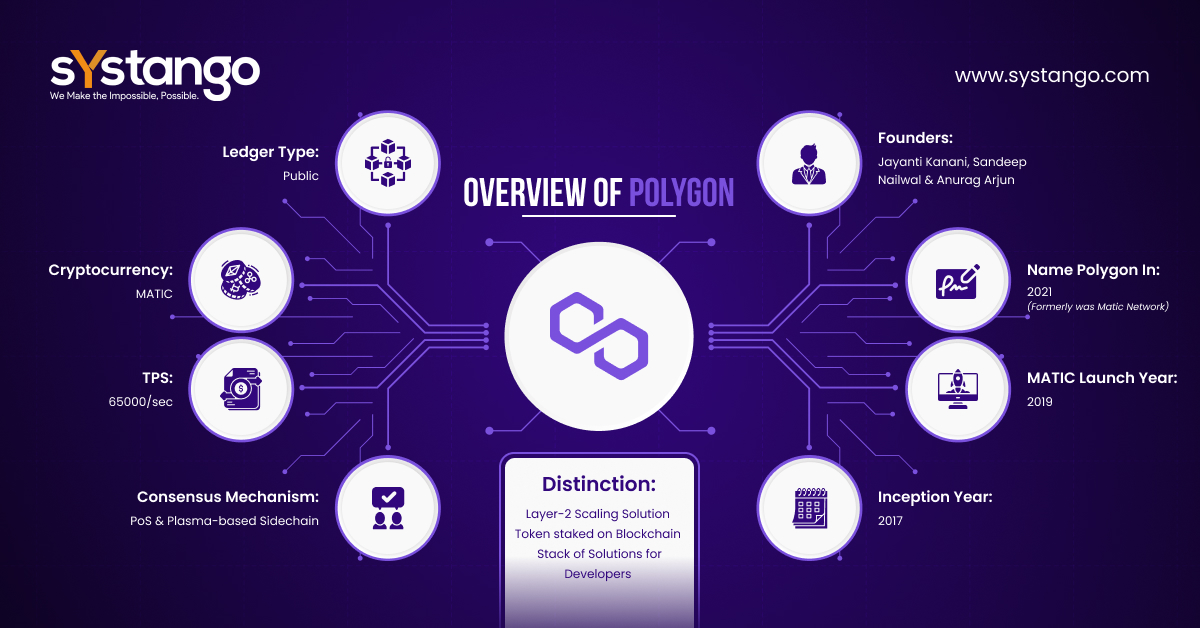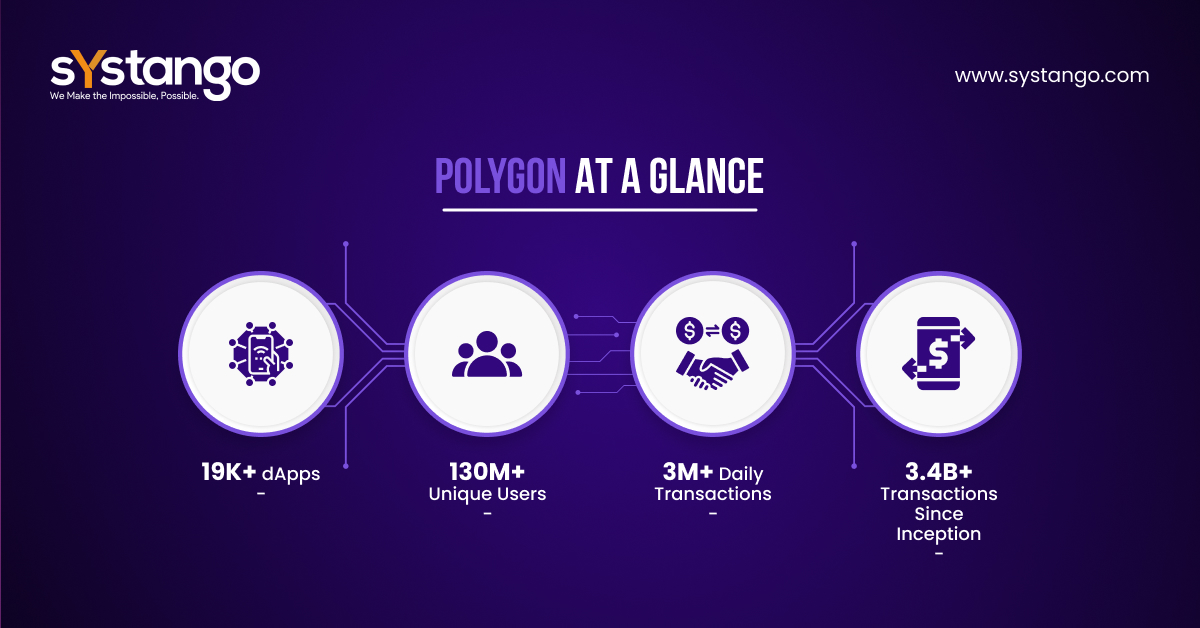All You Must Know About Polygon Blockchain Platform
Published on 30 Jun 2022

All You Must Know About Polygon Blockchain Platform
We have drafted a quick preface on the Polygon blockchain platform. This blog will help you understand the primary concepts around it. Let’s dive in!
In Brief:
- Polygon offers a well-rounded approach to scaling solutions. It answers the most pressing issues of Ethereum which includes high gas fees, and poor user experience.
- It provides wholesome infrastructure for a network of distinct and self-sovereign blockchains.
What will you learn?
- Polygon: Brief Story of Inception
- What is Polygon Blockchain?
- How does Polygon Solve Ethereum Issues?
- How does Polygon Work?
- How are sidechains being built?
- MATIC: Polygon’s Native Crypto
- Why should you prefer Polygon blockchain?

Polygon: Brief Story of Inception
Coming from the roots of India, Polygon was initially launched under the name ‘Matic Network’. It was founded in October 2017 by Sandeep Naliwal, Jaynti Kanani and Anurag Arjun.
The team of three co-founders went live with Matic Network in 2020 and attracted top names from the world of Defi such as MakerDAO and Decentraland.
In early 2021, Mihailo Bjelic joined the team as the fourth co-founder when the ‘Matic Network’ was rebranded as ‘Polygon’.
The co-founders developed this blockchain platform to address recurring issues of congested networks and high gas fees on Ethereum.
What is Polygon Blockchain?
Polygon platform offers off-chain scaling solutions to deliver superior user experiences to DApps/user functionalities built on top of Ethereum. It has been introduced to solve the usability and scalability issues that exist on Ethereum.
“Polygon is approaching 1 million unique addresses, which is 30–50% of where Ethereum is today.”
Polygon‘s vision circles around Ethereum, a blockchain platform that hosts a range of decentralised applications. It also is a platform for playing games, creating virtual worlds, developing NFTs, and much more. However, this continued rendering of the platform has made Ethereum almost unusable.
Now, Polygon as an add-on layer to Ethereum, without compromising on decentralisation, is leveraging the existing developer community and ecosystem to serve a scalable and usable platform.
Still confused about how Polygon is solving the issues of Ethereum! Let’s discuss it in detail.
How does Polygon Solve Ethereum Issues?
“Polygon can handle up to 65,000 transactions whereas Ethereum can process only up to 17 transactions per second.”
If you’re a blockchain enthusiast you might already know that there are severe scalability and gas fee issues with Ethereum. These problems have been constantly taking a toll on the development process and end-user experience.
Scalability issues for Crypto Kitties on Ethereum are a classic example of how the platform has been restricting devs from bringing the best from the platform.
While everyone is trying to take out the best from Ethereum, the platform has frequently been clogged, making the transactions on it costly for everyone. These multiple reasons have left no viable alternative for blockchain fanatics to come up with more reliable and scalable solutions. With its innovative and one-of-a-kind Layer-2 solution, Polygon emerged as an ingenious problem solver for developers.
You must note, that being a layer-2 solution, Polygon does not demand its own primary blockchain to function. Instead, it operates on Ethereum’s network only but intelligently diverts traffic and transactions per second away from the main chain, freeing up the computational power. This makes the whole system more effortless and economical.
How does Polygon Work?
You have heard enough of Polygon bringing a scaled version of Ethereum. But, how does it exactly do it?
To ease your understanding of what Polygon does, consider Ethereum operating as a local train and Polygon as an express train. Now imagine if the local train takes multiple stops, it will make the journey tedious and pointless. On the other hand, when the express train takes fewer stops, it delivers a much more satisfying journey.
That’s what happens. Polygon employs a combination of technologies to create this speedy sidechain and link it to the main Ethereum blockchain. With its range of modules, Polygon delivers a robust ecosystem to meet developers’ tailored requirements.
You must know that blockchains on the Polygon network operate on proof-of-stake (PoS). Within its ecosystem, it leverages a network of validators off the blockchain and then finalizes the transactions on the main chain (which is that of Ethereum). So, in this way Polygon is able to take off the majority of load/strain from the main blockchain, which results in faster transactions, lower gas fees, and less network congestion.
Note: Polygon’s working process is similar to Polkadot, Cosmos, and Avalanche but with an added advantage of Ethereum’s robust security and protocol.
Polygon’s Architecture
The architecture of Polygon is quite simple to understand. Polygon software development kit (SDK) is being utilised to create Ethereum-compatible decentralized applications as sidechains.
How are sidechains being built?
On Polygon, sidechains can be built by using one of the following scalability infrastructures:
- Plasma Chains: A layer-2 solution with Ethereum’s secure infrastructure to build dApps off-chain.
- Optimistic Rollups: Executes transactions off-chain and submits only proof of fraud to the main blockchain if an invalid block is discovered.
- zk-Rollups: Authorizes multiple transfers to be bundled into a single transaction. Requires submitting only the proof of validity to the main Ethereum chain.
- Validum Chains: Similar to ZK Rollups, this layer-2 solution keeps data availability off-chain to prevent funds from being stolen.
- Stand-Alone Chains: Secured by Validators, these independent Ethereum side chains can be connected to the main blockchain via bridges.
- Shared Security Chains: Blockchain-as-a-service, operates on a validation service that is provided by a shared pool of PoS validators.
All the above-listed solutions and others being developed by Polygon are all built to boost the transaction throughput of Ethereum. These are being built and deployed for developers without sacrificing the network’s user experience and security.
Find more information on Scalable Solutions by Polygon here.
MATIC: Polygon’s Native Token
We all now know that Polygon’s plasma chains are running on the PoS consensus mechanism. MATIC, its native cryptocurrency is used for the following tasks:
- Completing transactions on the platform
- Drive development across the network
- Staking and paying for transaction fees
Users on Polygon can earn MATIC tokens by offering computational resources and services to the network. In other words, it can be accomplished by executing transactions and validating transactions on the network.
The supply of MATIC tokens is limited, which means that there will only ever be 10 billion MATIC coins in circulation. At the time of writing this blog, there are approximately 5 billion tokens already being circulated in the market.
The more blockchain development projects on Polygon for scaling, the greater will be the demand for MATIC.
Why should you prefer Polygon blockchain?

Focused on blockchain interoperability and scaling, Polygon has emerged as one of the most exciting and talked about projects. It has witnessed exponential growth by offering an all-out set of tools for blockchain developers to build high-scaling blockchain applications and deliver high-performance dApps.
Polygon has registered itself as the only scalability solution to fully support the Ethereum Virtual Machine(EVM).
With a complete suite of Ethereum-scaling solutions, Polygon drives the development of blockchain applications faster and safer.
Takeaway
You must also know that the owner of MATIC holds the right to vote on which of the scaling solutions should actually be rolled out on Polygon. So, if there’s a new layer-2 scaling solution introduced within the community, MATIC holders may vote on whether it should become part of Polygon’s product line.
Are you planning to develop a blockchain application on Polygon?
Our blockchain experts might help you in building reliable, trusted and sustainable ecosystems for your business using Blockchain.
As leading blockchain developers in the UK, we work with all popular blockchain and smart contract platforms to develop custom blockchain solutions.
Connect with Us, today!
Related posts
Web 3
Blockchain
Inside Bittensor: How Decentralised Machine Learning Is Redefining AI Collaboration
10 Nov 2025
Blockchain
Blockchain Development Services for Enterprises: Unlock Efficiency, Trust, and Real Business Impact
21 May 2025
Let’s talk, no strings attached.